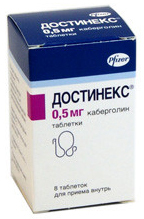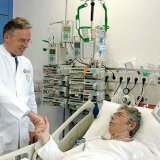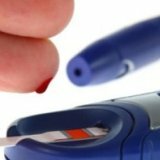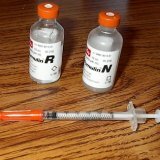Hyperprolactinemia in men
Hyperprolactinemia is a condition characterized by an increased prolactin( PRL) content in the blood. Among endocrine pathologies has a frequent manifestation, but is more common in women( about 7 times) than in men. This condition is also called hyperprolactinemic hypogonadism, being a form of hypogonadism( not all authors agree with this classification).
content
- 1 reasons
- 2 clinical manifestation
- 3
- 4 Diagnosis Treatment
- 4.1 Pharmacotherapy
- 4.2 Surgery
reasons
Depending on the reasons are the following forms hyperprolactinemia:
1. Physiological hyperprolactinemia not associated with pathological changes and is a consequence of the natural increase secretionHormone due to:
- sleep;
- physical activities;
- stress situations( the correlation is not proven);
- reception of protein food;
- medical and surgical interventions;
- hypoglycemia( lowering of blood glucose).
2. Pathological hyperprolactinemia, is a consequence of diseases and pathological changes in the body( tumors).The causes of pathological hyperprolactinemia can be:
- diseases and tumors of the hypothalamus and pituitary gland;
- primary hypothyroidism;
- chronic prostatitis;
- systemic lupus erythematosus;
- chronic renal failure;
- cirrhosis;
- work disruption and adrenal disease;
- idiopathic hyperprolactinaemia( when the cause of increased PRL is not established).
3. Pharmacological hyperprolactinemia caused by medication:
- antihypertensive drugs( reserpine, methyldopa);
- antidepressants( sulprimide, amitriptyline, imipramine, doxepin);
- preparations of estrogen;
- drugs( morphine, heroin, cocaine, amphetamines, hallucinogens);
- calcium antagonists( verapamil);
- antagonists of histamine H2 receptors( cimetidine, famotidine).
To determine the nature of treatment, it is customary to isolate:
- Tumor( macro and microprolactinoma) hyperprolactinemia;
- Non-tumor hyperprolactinemia.
Clinical manifestation of
In men, a high level of prolactin is manifested by the following symptoms:
- Decrease or absence of libido and potency( 50-85%);
- Infertility due to oligospermia( 3-15%);
- Reduction of secondary sexual characteristics( 2-21%);
- Gynecomastia( 6-23%);
- Metabolic disorders( obesity, hypercholesterolemia);
- Osteopenia and osteoporosis, bone pain( observed with prolonged hyperprolactinaemia);
- Psychoemotional disorders( depression, sleep disturbance, fatigue, memory loss).
Diagnosis
The main diagnostic marker is a triplicate blood test for prolactin. The analysis for hormones is carried out on different days, the interval between which is 7-10 days.
The level of PRL usually indicates the size of prolactinoma:
- the level of PRL in 200 ng / ml( 4000 mU / l) is characteristic for macroprolactinoma;
- a PRL level of less than 200 ng / ml( 4000 mU / L) may indicate the presence of micropropactinoma or idiopathic hyperprolactinemia;
- moderately elevated levels of PRL( 40-85 ng / ml or 800-1700 mU / l) are more common in craniopharyngioma, hypothyroidism, and drug hyperprolactinaemia;
- Periodic increases in the level of PRL are not necessarily associated with the presence of a tumor, and a combination of two or more provoking factors may be caused( for example, when patients with metoclopramide get renal insufficiency).
To clarify the diagnosis, you may need:
- MRI or CT of the hypothalamic-pituitary system, to detect macro and micropropactinoma, craniopharyngioma;
- Investigation of the fundus and visual fields, the pathology of which, as a rule, indicates a macro-prolactin;
- Ultrasound of the prostate.
Treatment of
Treatment of hyperprolactinemia means the normalization of prolactin levels. Normalization of the level of androgens with exogenous testosterone preparations is indicated only in cases when correction of hyperprolactinemia does not normalize the level of androgens.
With pharmacological hyperprolactinemia, drugs are canceled, and after three days, repeat the analysis for prolactin.
The main form of treatment for hyperprolactinemia of any form is drug therapy. Therapy with medications not only normalizes the level of PRL, but also reduces the size of the tumor( prolactinoma), and with prolonged treatment, in some cases, prolactinoma completely disappears.
Medication treatment
| Derivatives of ergot alkaloids( ergoline) |
|---|
 Bromocriptine preparations ( bromocriptine, lactodel, parlodel, sericryptin, apo-bromocriptine, Bromergon) - until recently was the only drug series in the treatment of hyperprolactinemia, but significant shortcomings in the form of a short half-life( 3-4hour) and pronounced side effects, forcing many patients to abandon its use. Up to 30% of patients are resistant to bromocriptine. Dosage features: starting at small doses( 0.625-1.25 mg( 1 / 4-1 / 2 tablets) before going to bed with food) increasing the dosage every 3-4 days by 0.625-1.25 mg until it is achieveda dose of 2.5-7 mg, taken fractional 2-3 times during the day during meals. The dose is selected individually for each patient, depending on the level of PRL achieved. Bromocriptine preparations ( bromocriptine, lactodel, parlodel, sericryptin, apo-bromocriptine, Bromergon) - until recently was the only drug series in the treatment of hyperprolactinemia, but significant shortcomings in the form of a short half-life( 3-4hour) and pronounced side effects, forcing many patients to abandon its use. Up to 30% of patients are resistant to bromocriptine. Dosage features: starting at small doses( 0.625-1.25 mg( 1 / 4-1 / 2 tablets) before going to bed with food) increasing the dosage every 3-4 days by 0.625-1.25 mg until it is achieveda dose of 2.5-7 mg, taken fractional 2-3 times during the day during meals. The dose is selected individually for each patient, depending on the level of PRL achieved. |
| Abergin is a domestic remedy that exerts a depressant effect on PRL, and does not affect the normal level of other pituitary hormones. Compared with bromocriptine has a longer PRL-inhibitory effect. By side effects aberhine is similar to bromocriptine, but has less pronounced hypotonic effect. Dosage features: is similar to dosing of bromocriptine. |
 Dostinex is a sustained release drug. It is the "gold standard" in the modern treatment of hyperprolactinemia in men. Its advantages over the preparations of bromocriptine are due to greater efficacy, convenience of use( 2 times a week, instead of everyday receptions), as well as lesser severity and frequency of side effects. Decrease in the level of PRL in the plasma is noted only 3 hours after taking and retains for 7-28 days. In addition to reducing the level of the hormone, there is a decrease in the tumor. Dosage features: , the usual therapeutic dose is 0.5-1 mg( 1-2 tablets) per week in 2 divided doses during meals, but the dosage can range from 0.25 to 4.5 mg per week. Dostinex is a sustained release drug. It is the "gold standard" in the modern treatment of hyperprolactinemia in men. Its advantages over the preparations of bromocriptine are due to greater efficacy, convenience of use( 2 times a week, instead of everyday receptions), as well as lesser severity and frequency of side effects. Decrease in the level of PRL in the plasma is noted only 3 hours after taking and retains for 7-28 days. In addition to reducing the level of the hormone, there is a decrease in the tumor. Dosage features: , the usual therapeutic dose is 0.5-1 mg( 1-2 tablets) per week in 2 divided doses during meals, but the dosage can range from 0.25 to 4.5 mg per week. |
| Derivatives of tricyclic benzoguanolines( nonergolinic) |
| Norprolac is a prolonged oral non -ergoline dopamine antagonist. The clinical effect of the drug manifests itself 2 hours after taking, and lasts about 24 hours, which allows taking the drug once during the day. It has better tolerability than bromocriptine preparations. Dosage features: initial dosage is 0.025 mg for the first 3 days, 0.05 mg for the next 3 days, after which the dose is increased to 0.075 mg. The subsequent increase in dosage( if necessary) is carried out at weekly intervals. |
Surgical treatment
Surgical treatment is prescribed in the case of:
- when drug therapy is not effective( tumor immunity to dopamine inhibitors);
- patient's immunity to dopamine inhibitors;
- threat of vision loss.
It is necessary to know that the frequency of recurrences of prolactinoma in patients, within 6 years after the operation, is 50%.Currently, due to the effectiveness of drug therapy, surgical treatment is rarely used.
Drug and surgical therapies are not mutually exclusive and can be used in complex therapies, for example, the previous operation of drug therapy to reduce the size of the tumor for more convenient surgical access.
The operation, with its successful outcome, has the advantage of a one-stage procedure, but, like any other surgical intervention, has its complications.
Sources:
1. G.A.Melnichenko, E.I.Marova, L.K.Dzeranova, V.V.Wax " Hyperprolactinaemia in women and men" .
2. S.Y.Kalinchenko, I.A.Tyuzikov «Practical Andrology».
Recommended for viewing:



